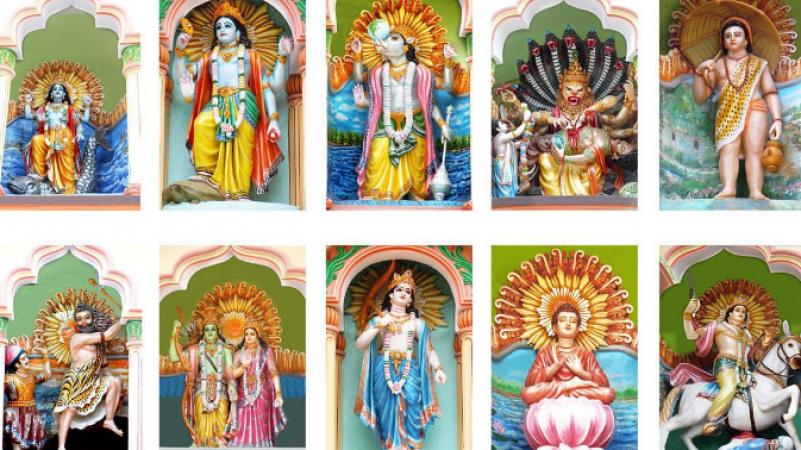
Lord Vishnu, one of the principal deities in Hinduism, is considered the preserver and protector of the universe. He is believed to have descended to Earth in various forms or avatars to restore balance and righteousness whenever it is threatened. These avatars embody different qualities and possess unique characteristics that fulfill specific divine purposes. In this article, we will explore the twelve avatars of Lord Vishnu, tracing their significance, stories, and the profound lessons they impart.
Matsya Avatar - The Fish Incarnation:
The first avatar of Lord Vishnu is Matsya, the fish. In this form, Vishnu saved humanity and the Vedas from a great flood by rescuing Manu, the progenitor of mankind. This avatar symbolizes the importance of preservation and protection.
Kurma Avatar - The Tortoise Incarnation:
In the form of a tortoise, Kurma, Lord Vishnu supported Mount Mandara during the churning of the cosmic ocean to obtain the nectar of immortality. This avatar signifies the need for stability and patience in the face of challenges.
Varaha Avatar - The Boar Incarnation:
The third avatar, Varaha, depicts Lord Vishnu in the form of a boar. Vishnu assumed this form to rescue the Earth goddess, Bhudevi, from the clutches of the demon Hiranyaksha. This avatar emphasizes the protection of righteousness and the eradication of evil forces.
Narasimha Avatar - The Lion-Man Incarnation:
Narasimha, the half-man and half-lion form, emerged to vanquish the demon king Hiranyakashipu, who had obtained a boon of invincibility. This avatar exemplifies the destruction of arrogance and the triumph of good over evil.
Vamana Avatar - The Dwarf Incarnation:
Vamana, the dwarf form of Lord Vishnu, incarnated to restore balance when the demon king Bali became an unruly ruler. Vishnu disguised himself as a dwarf and asked for three steps of land, which covered the entire universe. This avatar teaches humility and the importance of righteous rule.
Parashurama Avatar - The Warrior Sage Incarnation:
Parashurama, the warrior sage avatar, arose to eliminate the corrupt and oppressive Kshatriya kings from the Earth. He brandished a formidable axe and restored order, emphasizing the significance of upholding justice and protecting the weak.
Lord Rama - The Ideal King Incarnation:
Considered one of the most revered avatars, Lord Rama embodies righteousness, devotion, and dharma. His story, narrated in the epic Ramayana, emphasizes the importance of fulfilling one's duties, maintaining moral values, and the triumph of good over evil.
Lord Krishna - The Divine Teacher Incarnation:
Lord Krishna, the enchanting and charismatic incarnation, exemplifies divine love, wisdom, and knowledge. His teachings in the Bhagavad Gita explore the concepts of duty, devotion, and the ultimate path to salvation, leaving an indelible impact on humanity.
Buddha Avatar - The Enlightened Sage Incarnation:
The Buddha avatar, a unique manifestation of Lord Vishnu, spread the teachings of non-violence, compassion, and enlightenment. This avatar emphasizes the importance of self-realization and liberation from the cycle of birth and death.
Kalki Avatar - The Savior Incarnation:
The final avatar, Kalki, is yet to appear in the current cosmic cycle. Lord Vishnu will descend as Kalki at the end of the Kali Yuga, the age of darkness, to restore righteousness and usher in a new era of peace and harmony.
Conclusion:
The twelve avatars of Lord Vishnu reveal a profound understanding of divine purpose, righteousness, and the eternal battle between good and evil. Each avatar carries a unique message and imparts valuable lessons that guide humanity towards spiritual growth and moral living. By studying and reflecting upon these avatars, we can cultivate qualities such as patience, humility, righteousness, and devotion, which lead to a deeper connection with the divine.
In conclusion, the avatars of Lord Vishnu are not merely mythical tales but hold timeless wisdom and guidance for humanity. By embracing the virtues and lessons these avatars impart, individuals can strive towards personal growth, righteous living, and spiritual enlightenment.
Know about the roots of the ancient religion of India
Gomateshwara Temple: Monolithic Statues
The Significance of Bells in Temples: Unveiling Their Musical Charm